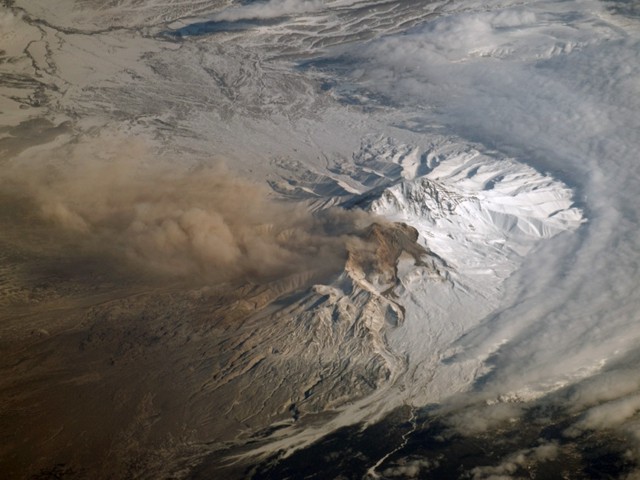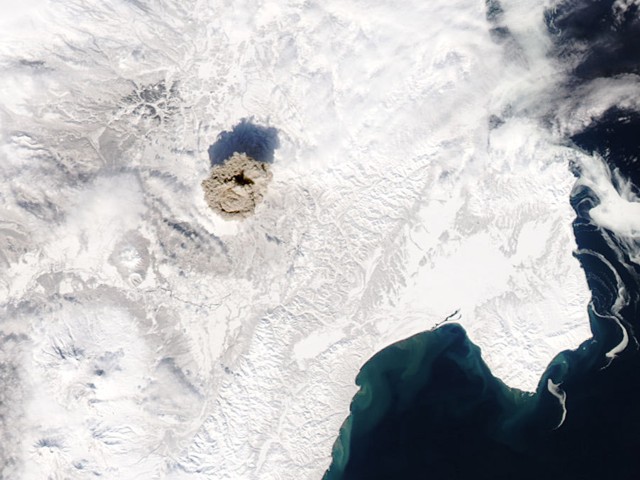Report on Sheveluch (Russia) — March 2007
Bulletin of the Global Volcanism Network, vol. 32, no. 3 (March 2007)
Managing Editor: Richard Wunderman.
Sheveluch (Russia) Ash plumes continued through at least April 2007
Please cite this report as:
Global Volcanism Program, 2007. Report on Sheveluch (Russia) (Wunderman, R., ed.). Bulletin of the Global Volcanism Network, 32:3. Smithsonian Institution. https://doi.org/10.5479/si.GVP.BGVN200703-300270
Sheveluch
Russia
56.653°N, 161.36°E; summit elev. 3283 m
All times are local (unless otherwise noted)
In December 2006 Shiveluch underwent heightened seismic and volcanic activity after more than a year of lesser activity (BGVN 31:11). After significant explosive activity during 26-27 December 2006 that caused the Kamchatkan Volcanic Eruption Response Team (KVERT) to briefly raise the hazard status, activity remained above background levels into January 2007.
The seismic network recorded 200 shallow earthquakes daily between 29 December and 12 January 2007, accompanied by fumarolic activity, avalanches, and gas-and-ash plumes that rose from 4.3 km to 13.7 km altitude, drifting E and SSW. A large thermal anomaly over the dome was noted.
Between 12 January to 16 February, this activity continued. The number of earthquakes dipped to as low as 120 per day before increasing to 200 again during 2-9 February. Plumes during this time rose to an altitude of 3.5-6.5 km and drifted in a variety of directions. The large thermal anomaly over the dome remained. An eruption occurred on 6 February that was not visible on satellite imagery.
Astronauts aboard the Space Shuttle noted a plume around 21 March (figure 10). On 29 March, an explosive event at Shiveluch produced an ash plume (figure 11) that, according to the Tokyo VAAC, reached an altitude of 11.9 km and drifted NE. The next day, an explosive event that lasted about 6 minutes produced a plume that reached altitudes of 10.1-12.2 km, and drifted NE. According to a news article, on 31 March, a mudflow covered an approximately 900-m-long section of road, in an area ~ 20 km from Shiveluch.
 |
Figure 10. Plume from Shiveluch taken by astronauts aboard the International Space Station (ISS) around mid-morning on or around 21 March 2007. Photograph ISS014-E-17165. Courtesy of NASA. |
In subsequent reports, KVERT indicated that seismic activity continued above background levels during 4-12 April. Based on seismic interpretation, observation, and video data, ash-and-steam plumes rose to altitudes of 4.5-7 km throughout this period. The large thermal anomaly was visible on satellite imagery during 1-10 April. As of 10 April, the Color Code at Shiveluch remained at Orange.
Geological Summary. The high, isolated massif of Sheveluch volcano (also spelled Shiveluch) rises above the lowlands NNE of the Kliuchevskaya volcano group. The 1,300 km3 andesitic volcano is one of Kamchatka's largest and most active volcanic structures, with at least 60 large eruptions during the Holocene. The summit of roughly 65,000-year-old Stary Shiveluch is truncated by a broad 9-km-wide late-Pleistocene caldera breached to the south. Many lava domes occur on its outer flanks. The Molodoy Shiveluch lava dome complex was constructed during the Holocene within the large open caldera; Holocene lava dome extrusion also took place on the flanks of Stary Shiveluch. Widespread tephra layers from these eruptions have provided valuable time markers for dating volcanic events in Kamchatka. Frequent collapses of dome complexes, most recently in 1964, have produced debris avalanches whose deposits cover much of the floor of the breached caldera.
Information Contacts: Olga A. Girina, Kamchatka Volcanic Eruptions Response Team (KVERT), a cooperative program of the Institute of Volcanic Geology and Geochemistry, Far East Division, Russian Academy of Sciences, Piip Ave. 9, Petropavlovsk-Kamchatsky, 683006, Russia; Kamchatka Experimental and Methodical Seismological Department (KEMSD), Geophysical service of the Russian Academy of Science (Russia) (URL: http://kbgs.kscnet.ru/information-e.html); Tokyo Volcanic Ash Advisory Center, Tokyo Aviation Weather Service Center, Haneda Airport 3-3-1, Ota-ku, Tokyo 144-0041, Japan (URL: https://ds.data.jma.go.jp/svd/vaac/data/); Alaska Volcano Observatory (AVO), a cooperative program of the U.S. Geological Survey, 4200 University Drive, Anchorage, AK 99508-4667, USA (URL: http://www.avo.alaska.edu/), Geophysical Institute, University of Alaska, PO Box 757320, Fairbanks, AK 99775-7320, USA, and the Alaska Division of Geological and Geophysical Surveys, 794 University Ave., Suite 200, Fairbanks, AK 99709, USA; Yelizovo Meteorological Watch Office, Yelizovo Airport Aviation Meteorology Center, Petropavlovsk-Kamchatsky, Russian Federation, 684010 Kamchatka; Itar-Tass (URL: http://tass.ru/eng/); US National Aeronautics and Space Administration, NASA.


